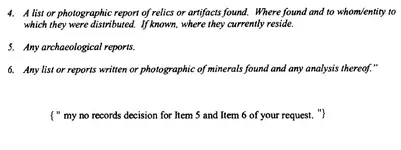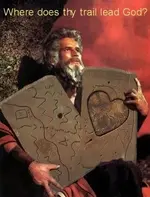Here is the story as told by rancher Billy Martin and from the County records concerning Ted Cox and the Rogers spring "HEAT" excavation.
The Roger’s Spring archaeology site is on the southwest base of Iron Mountain and was also known as the HEAT dig. This site was first excavated by Quentin (Ted) Cox in 1958 and later excavated by the HEAT team in September 2004.
The archaeology report on the Roger’s Spring (HEAT) dig was done by a private firm and paid for by private individuals. The archaeologists, Steinbeck and Rice did not do the actual excavation of the artifacts found at the site.
In 2004 the Roger’s Spring (HEAT) dig received a USFS permit to dig at the spring which allowed them to improve the flow of water from the spring for wildlife and clean up the site when they were finished.
The story of the HEAT dig is based on the notes and letters of Quentin (Ted) Cox in the 1950’s. Cox read the book Lost Mines and Buried Treasures (John Mitchell 1953) and decided the Lost Dutchman Mine was an old Spanish/Mexican mine that Jacob Waltz found in the Iron Mountain Pinto Creek area of the eastern Superstitions.
Cox believed this due to a story Mitchell wrote about an old carpenter from Florence, Arizona named “Frank” who built a rocker/washer for Jacob Waltz and learned Waltz had a mine in the Pinto Creek area on the southwest side of Iron Mountain. Mitchell provided a map of the Iron Mountain search area.
In 1958, searching with two friends (Bud Dunn and Wally Blake) from Torrance, CA. Cox believed Roger’s Spring, a water source for cattle on the range of rancher Billy Martin was the site of Waltz’s mine and or cache.
Martin owned the JF Ranch southwest of Rogers spring and had at an earlier time dug a tunnel back to the Roger’s spring head in an effort to open the spring up. Rogers spring originally flowed out of the base of Iron mountain but the flow was often weak so Martin decided to dig back into the mountain to reach a place where he could open the spring further and greatly improve its flow.
After digging a 25-30 foot tunnel back into the mountain Martin was able to open up the flow.
Martin tapped the spring and ran a pipe out of the tunnel to create a pool of water for his cattle. Martin then proceeded to cave in the tunnel so animals couldn’t get inside the tunnel and foul the water.
When Ted Cox first saw the caved in tunnel he was certain it was Waltz’s mine and cache, the mine Mitchell wrote about in his book. Cox could easily see the pipe and water coming out of the caved in area but evidently it didn’t make any difference to him. Cox and his partners went on top of a small rise directly above the spring and proceeded to dig a shaft down to meet the caved in tunnel.
Rancher Martin soon noticed the men digging and told them to stop and get off his range. Cox persisted with his digging and several encounters between Cox and Martin ensued.
Ted Cox wrote several letters to the USFS and his Congressman complaining about Martin and his efforts to deny him access to Waltz’s mine. Things came to a head when rancher Martin encountered Cox and his partners driving an excavator up the trail to the Roger’s trough and mill site. An angry, potentially dangerous encounter ensued and the Sheriff was called to advise Cox to cease and desist.
Cox wasn’t through however and his crew succeeded in digging the shaft down toward the spring where he said he encountered a main tunnel and two side chambers, one going to the right and one going to the left. Cox told a story that he and his crew excavated one of the chambers but never got the chance to excavate the other one.
Cox said that in his digging he had found a cache of gold bullion, some Spanish or Mexican type artifact, a rock wall and even some human remains. But he was never able to remove any of the gold and treasure due to “life threatening circumstances”.
About this time there was a falling out between Cox and his two partners and the two men angrily quit Cox and the search and returned to California.
Quentin Ted Cox eventually alienated every rancher and Sheriff’s deputy in the County and he tried to sue the ranchers and the County for denying him access to the area of his mine. Cox was a prolific letter writer and to read his many letters and notes will give anyone a pounding headache as his printing was a style of hieroglyphics that made your eyes blur.
Cox alleged that the local ranchers were trying to ambush him with rifles from hidden places on a high ridge and interfering with his ability to dig and remove the bullion. The ridge was Roger’s Ridge but Cox called it “Falda Ridge.”
Quentin Ted Cox died in 1983. His notes and letters are fascinating and if you can follow his sometimes pointless thought process, there is the possibility you might be captivated by his story of gold and Spanish treasure.
Incredibly, Cox’s notes and letters were used by the USFS to justify the special permit for HEAT to dig at the site even though members of the Martin family told the Forest Service there had never been any excavation done there until Billy Martin Sr. had dug into the mountain to improve the flow of the spring.
Matthew




 Dr. Glover asked me what I thought Ron had at the dig. My reply was "an old spring for the cattlemen's operations. Believe that's what it turned out to be.
Dr. Glover asked me what I thought Ron had at the dig. My reply was "an old spring for the cattlemen's operations. Believe that's what it turned out to be.



